Introduction to runes
In the past years Runes have been increasingly used as tools for divination, readings, and advice. Of course people who cast Runes are no longer doing this to find out the will of the gods. Some neo-odinist circles may be an exception to that.
Runes are an excellent tool to find advice, to help in spiritual evaluation, and to help in personal growth. They help you know the trends of your future. Knowing these trends will help you in your decision making processes. Then, once you decided for a course of action that is based on a Rune reading, you can use Runes again to find out the outcome of your decision.
Knowing trends of the future is worth a fortune! Many successful people reached their positions because they gained insight in future trends and acted accordingly.
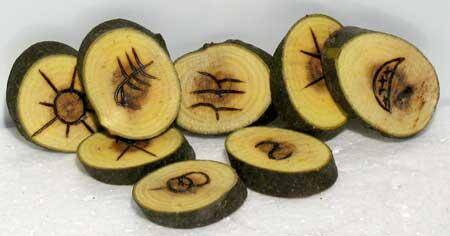
Managing trends of the future is still better than just knowing them! The Runes can be a significant help to manage your trends, especially when you boost them with a Welz Chi Generator!
This is so, because the use of Runes goes much beyond giving readings. Runes are a system of creative energies. You can use these energies to find out about trends and you can use them to make trends or manage trends. This way, Runes help you to have influence on your future. You may use Runes to change negative trends, even to eliminate them. Conversely you can use Runes to enhance positive trends of destiny.
The present course has the purpose to give you a comprehensive introduction into Rune readings.
The following lessons will provide you with a no nonsense approach that will allow you to practice Rune readings within a relatively short time.
The instructions are easy to follow by anyone who is willing to invest some time into Runic practice.
Repeated practice will rapidly develop your skills as a Rune reader.
Runic alphabets
Let us begin with a quick overview of the main types of runes or the main rune sets talked about. Plus, note that witch runes are completely different from these in this free runes course. We do not teach witch runes here, but bring their existence to your attention.
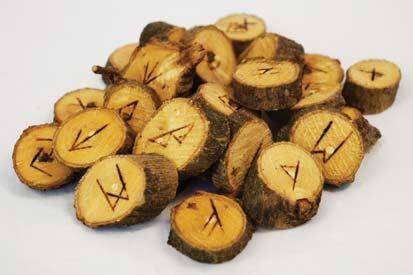
Elder Futhark (2nd to 8th centuries)
The Elder Futhark, used for writing Proto-Norse, consists of 24 runes that often are arranged in three groups of eight; each group is referred to as anÆtt. The earliest known sequential listing of the full set of 24 runes dates to approximately CE 400 and is found on the Kylver Stone in Gotland, Sweden.
Most probably each rune had a name, chosen to represent the sound of the rune itself. The names are, however, not directly attested for the Elder Futhark themselves.
Reconstructed names in Proto-Germanic have been produced, based on the names given for the runes in the later alphabets attested in the rune poems and the linked names of the letters of the Gothic alphabet. The letter /a/ was named from the runic letter Runic letter ansuz.svg called Ansuz.
An asterisk before the rune names means that they are unattested reconstructions.
The 24 Elder Futhark runes are:
| Rune | UCS | Transliteration | IPA | Proto-Germanic name | Meaning |
|---|---|---|---|---|---|
| ᚠ | f | /f/ | *fehu | “wealth, cattle” | |
| ᚢ | u | /u(ː)/ | ?*ūruz | “aurochs” (or *ûram “water/slag”?) | |
| ᚦ | þ | /θ/, /ð/ | ?*þurisaz | “the god Thor, giant” | |
| ᚨ | a | /a(ː)/ | *ansuz | “one of the Æsir (gods)” | |
| ᚱ | r | /r/ | *raidō | “ride, journey” | |
| ᚲ | k (c) | /k/ | ?*kaunan | “ulcer”? (or *kenaz “torch”?) | |
| ᚷ | g | /ɡ/ | *gebō | “gift” | |
| ᚹ | w | /w/ | *wunjō | “joy” | |
| ᚺ ᚻ | h | /h/ | *hagalaz | “hail” (the precipitation) | |
| ᚾ | n | /n/ | *naudiz | “need” | |
| ᛁ | i | /i(ː)/ | *īsaz | “ice” | |
| ᛃ | j | /j/ | *jēra- | “year, good year, harvest” | |
| ᛇ | ï (æ) | /æː/(?) | *ī(h)waz/*ei(h)waz | “yew-tree” | |
| ᛈ | p | /p/ | ?*perþ- | meaning unclear, perhaps “pear-tree”. | |
| ᛉ | z | /z/ | ?*algiz | unclear, possibly “elk”. | |
| ᛊ ᛋ | s | /s/ | *sōwilō | “Sun” | |
| ᛏ | t | /t/ | *tīwaz/*teiwaz | “the god Tiwaz” | |
| ᛒ | b | /b/ | *berkanan | “birch” | |
| ᛖ | e | /e(ː)/ | *ehwaz | “horse” | |
| ᛗ | m | /m/ | *mannaz | “Man” | |
| ᛚ | l | /l/ | *laguz | “water, lake” (or possibly *laukaz “leek”) | |
| ᛜ ᛝ | ŋ | /ŋ/ | *ingwaz | “the god Ingwaz” | |
| ᛟ | o | /o(ː)/ | *ōþila-/*ōþala- | “heritage, estate, possession” | |
| ᛞ | d | /d/ | *dagaz | “day” |
Anglo-Saxon runes (5th to 11th centuries)
The futhorc are an extended alphabet, consisting of 29, and later, even 33 characters. It probably was used from the 5th century onward.
There are competing theories as to the origins of the Anglo-Saxon Fuþorc. One theory proposes that it was developed in Frisia and later spread to England.
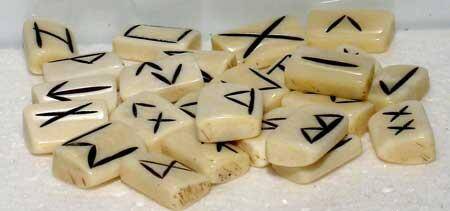
Another holds that runes were introduced by Scandinavians to England where the fuþorc was modified and exported to Frisia. Both theories have their inherent weaknesses and a definitive answer likely awaits more archaeological evidence.
Futhorc inscriptions are found e.g. on the Thames scramasax, in the Vienna Codex, in Cotton Otho B.x (Anglo-Saxon rune poem) and on the Ruthwell Cross.
The Anglo-Saxon rune poem gives the following characters and names: ᚠ feoh, ᚢ ur, ᚦ thorn, ᚩ os, ᚱ rad, ᚳ cen, ᚷ gyfu, ᚹ wynn, ᚻ haegl, ᚾ nyd, ᛁ is, ᛄger, ᛇ eoh, ᛈ peordh, ᛉ eolh, ᛋ sigel, ᛏ tir, ᛒ beorc, ᛖ eh, ᛗ mann, ᛚ lagu, ᛝ ing, ᛟ ethel, ᛞ daeg, ᚪ ac, ᚫ aesc, ᚣ yr, ᛡ ior, ᛠ ear.
The expanded alphabet features the additional letters ᛢ cweorth, ᛣ calc, ᛤ cealc, and ᛥ stan. These additional letters have only been found in manuscripts. Feoh, þorn, and sigel stood for [f], [þ], and [s] in most environments, but voiced to [v], [ð], and [z] between vowels or voiced consonants. Gyfu and wynn stood for the letters yogh and wynn, which became [g] and [w] in Middle English.
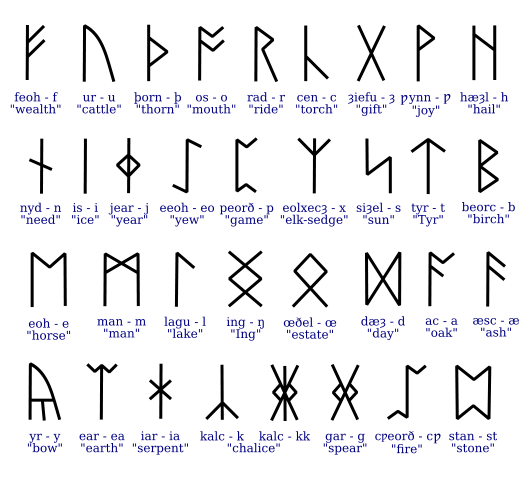
“Marcomannic runes” (8th to 9th centuries) Marcomannic
A runic alphabet consisting of a mixture of Elder Futhark with Anglo-Saxon futhorc.
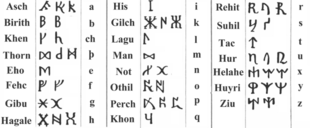
Younger Futhark (9th to 11th centuries) runes
The Younger Futhark, also called Scandinavian Futhark, is a reduced form of the Elder Futhark, consisting of only 16 characters.
The reduction correlates with phonetic changes when Proto-Norseevolved into Old Norse. They are found in Scandinavia and Viking Age settlements abroad, probably in use from the 9th century onward. They are divided into long-branch (Danish) and short-twig (Swedish and Norwegian) runes. The difference between the two versions is a matter of controversy. A general opinion is that the difference between them was functional (i.e., the long-branch runes were used for documentation on stone, whereas the short-branch runes were in everyday use for private or official messages on wood).
Medieval runes (12th to 15th centuries) runes
In the Middle Ages, the Younger Futhark in Scandinavia was expanded, so that it once more contained one sign for each phoneme of the Old Norse language. Dotted variants of voiceless signs were introduced to denote the corresponding voiced consonants, or vice versa, voiceless variants of voiced consonants, and several new runes also appeared for vowel sounds. Inscriptions in medieval Scandinavian runes show a large number of variant rune forms, and some letters, such as s, c, and z often were used interchangeably.
Medieval runes were in use until the 15th century. Of the total number of Norwegian runic inscriptions preserved today, most are medieval runes. Notably, more than 600 inscriptions using these runes have been discovered in Bergen since the 1950s, mostly on wooden sticks (the so-called Bryggen inscriptions). This indicates that runes were in common use side by side with the Latin alphabet for several centuries. Indeed, some of the medieval runic inscriptions are written in Latin language.

Dalecarlian runes (16th to 19th centuries) runes
The Dalecarlian runes came into use in the early 16th century and remained in some use up to the 20th century. Some discussion remains on whether their use was an unbroken tradition throughout this period or whether people in the 19th and 20th centuries learned runes from books written on the subject.

